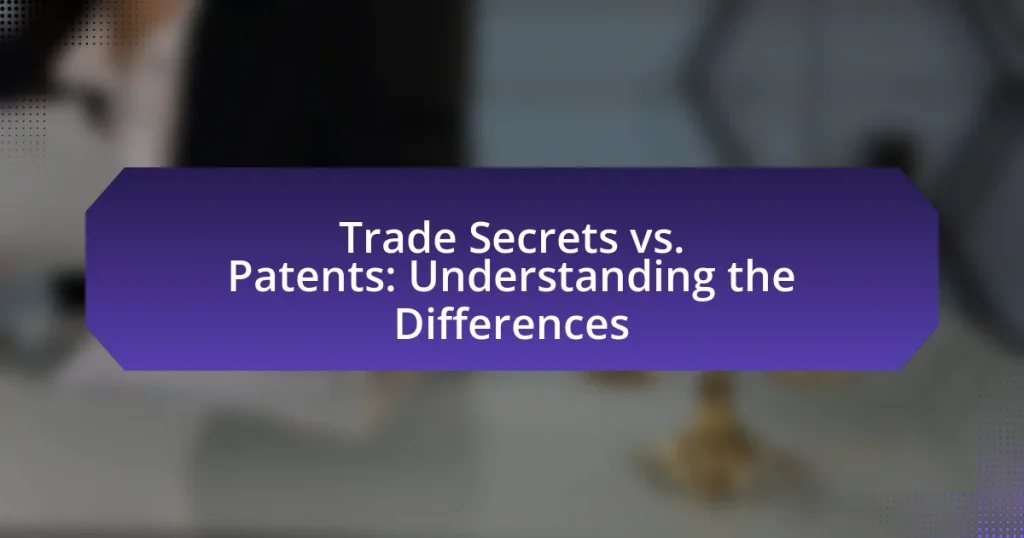The article addresses common misconceptions about trade secrets in business, clarifying that not all confidential information qualifies as a trade secret and that protective measures are essential for safeguarding such information. It explores the reasons behind these misconceptions, including a lack of understanding of legal definitions and cultural perceptions, as well as historical factors that have contributed to confusion. The article emphasizes the importance of actively managing trade secrets through confidentiality agreements, employee training, and regular audits to mitigate risks and protect valuable proprietary information effectively. Additionally, it highlights the financial implications of failing to protect trade secrets and provides practical strategies for businesses to enhance their understanding and management of these critical assets.

What are Common Misconceptions About Trade Secrets in Business?
Common misconceptions about trade secrets in business include the belief that all confidential information qualifies as a trade secret, that trade secrets do not require any protective measures, and that they are protected indefinitely without any effort. Not all confidential information is a trade secret; for information to qualify, it must be secret, have economic value, and be subject to reasonable efforts to maintain its secrecy. Additionally, businesses must actively implement protective measures, such as non-disclosure agreements and security protocols, to safeguard trade secrets. Lastly, while trade secrets can last indefinitely, they can be lost if the information becomes public or if the business fails to take necessary precautions to keep it confidential.
Why do misconceptions about trade secrets exist?
Misconceptions about trade secrets exist primarily due to a lack of understanding regarding their legal definition and protection mechanisms. Many individuals conflate trade secrets with patents or copyrights, assuming that they require formal registration or public disclosure, which is not the case; trade secrets are protected as long as they remain confidential. Additionally, the complexity of trade secret laws, which can vary significantly by jurisdiction, contributes to confusion. For instance, the Uniform Trade Secrets Act in the United States provides a legal framework, but not all states have adopted it, leading to inconsistent interpretations and enforcement. This legal ambiguity, combined with the general public’s limited exposure to intellectual property law, fosters misconceptions about what constitutes a trade secret and how it can be safeguarded.
What historical factors contribute to these misconceptions?
Historical factors contributing to misconceptions about trade secrets in business include the lack of formal legal frameworks and the evolution of intellectual property laws. In the early 20th century, trade secrets were often not recognized as a distinct category of intellectual property, leading to confusion about their protection and value. The Uniform Trade Secrets Act, enacted in 1979, began to standardize the definition and protection of trade secrets across states, but prior to this, many businesses operated under varying interpretations of what constituted a trade secret. Additionally, historical cases, such as the 1931 case of E.I. du Pont de Nemours & Co. v. Masland, highlighted the ambiguity surrounding trade secret protection, further perpetuating misconceptions. These factors combined have led to a persistent misunderstanding of trade secrets as merely informal business practices rather than legally protected assets.
How do cultural perceptions influence understanding of trade secrets?
Cultural perceptions significantly influence the understanding of trade secrets by shaping attitudes toward confidentiality and intellectual property. In cultures that prioritize collectivism, such as many Asian societies, there is often a stronger emphasis on group harmony and shared knowledge, which can lead to a more lenient view of trade secrets. Conversely, in individualistic cultures, like those in the United States, there is a heightened focus on personal ownership and protection of proprietary information, resulting in stricter enforcement of trade secret laws. For instance, the Uniform Trade Secrets Act in the U.S. reflects this individualistic approach by providing legal frameworks that protect businesses’ confidential information, whereas in some collectivist cultures, the sharing of information may be seen as a means of fostering collaboration rather than competition. This divergence in cultural attitudes can lead to misunderstandings and conflicts in international business dealings regarding what constitutes a trade secret and how it should be protected.
What are the most prevalent misconceptions about trade secrets?
The most prevalent misconceptions about trade secrets include the belief that they must be formally registered, that they are only applicable to large corporations, and that they are protected indefinitely without any effort. Trade secrets do not require registration; they are protected as long as they remain confidential and provide economic value, as outlined in the Uniform Trade Secrets Act. Additionally, trade secrets are relevant to businesses of all sizes, not just large corporations, as small businesses can also possess valuable proprietary information. Lastly, while trade secrets can be protected indefinitely, companies must actively take steps to maintain their secrecy, such as implementing non-disclosure agreements and security measures.
Is a trade secret the same as a patent?
A trade secret is not the same as a patent. A trade secret refers to confidential business information that provides a competitive edge, such as formulas, practices, or processes, and is protected as long as it remains secret. In contrast, a patent is a legal right granted for an invention, providing exclusive rights to the inventor for a limited time, typically 20 years, in exchange for public disclosure of the invention. The key distinction lies in the protection mechanism: trade secrets rely on confidentiality, while patents require public disclosure and formal registration.
Do trade secrets require formal registration?
Trade secrets do not require formal registration. Unlike patents or trademarks, trade secrets are protected by law as long as they remain confidential and provide a competitive advantage. The Uniform Trade Secrets Act and the Defend Trade Secrets Act in the United States establish that protection is granted through reasonable efforts to maintain secrecy, rather than through a formal registration process.
Can trade secrets be protected indefinitely?
Trade secrets can be protected indefinitely as long as they remain confidential and provide economic value. The legal framework surrounding trade secrets, primarily governed by the Uniform Trade Secrets Act and the Defend Trade Secrets Act in the United States, does not impose a time limit on their protection. For instance, companies like Coca-Cola have maintained the secrecy of their formulas for over a century, demonstrating that as long as the information is not disclosed or independently discovered, it can be protected indefinitely.

How do Misconceptions Impact Businesses?
Misconceptions negatively impact businesses by leading to poor decision-making and strategic errors. For instance, a common misconception is that all trade secrets must be formally documented to be protected; however, this is not true, as trade secrets can exist in any form as long as they are kept confidential. This misunderstanding can result in businesses failing to adequately protect valuable information, leading to potential loss of competitive advantage. According to the World Intellectual Property Organization, companies that do not recognize the importance of trade secrets may face increased risks of theft and misappropriation, ultimately harming their market position and profitability.
What risks do businesses face due to these misconceptions?
Businesses face significant risks due to misconceptions about trade secrets, primarily including legal exposure, loss of competitive advantage, and financial repercussions. Misunderstanding the legal protections surrounding trade secrets can lead to unintentional disclosures, resulting in lawsuits or penalties. For instance, a study by the Economic Espionage Act indicates that companies failing to adequately protect their trade secrets can suffer losses exceeding $300 billion annually. Additionally, misconceptions may cause businesses to underestimate the importance of confidentiality agreements, leading to unauthorized sharing of sensitive information and ultimately diminishing their market position.
How can misunderstanding trade secrets lead to legal issues?
Misunderstanding trade secrets can lead to legal issues by causing individuals or organizations to inadvertently disclose or misuse confidential information. When a party misinterprets what constitutes a trade secret, they may fail to implement adequate protective measures, resulting in unauthorized access or sharing of sensitive data. For instance, the Uniform Trade Secrets Act defines trade secrets as information that derives economic value from not being generally known and is subject to reasonable efforts to maintain its secrecy. If a business does not recognize certain information as a trade secret, it may not take necessary precautions, leading to potential theft or infringement claims. Legal disputes can arise when one party claims that another has misappropriated their trade secrets, resulting in costly litigation and potential damages.
What are the financial implications of failing to protect trade secrets?
Failing to protect trade secrets can lead to significant financial losses for a business. When confidential information is disclosed or misappropriated, companies may experience decreased competitive advantage, resulting in lost revenue and market share. For instance, a study by the Economic Espionage Act indicated that trade secret theft costs U.S. businesses approximately $300 billion annually. Additionally, companies may incur legal expenses related to litigation and enforcement actions against the parties responsible for the breach. The cumulative effect of these factors can severely impact a company’s profitability and long-term viability.
How can businesses effectively manage trade secrets?
Businesses can effectively manage trade secrets by implementing robust confidentiality policies and employee training programs. Establishing clear protocols for identifying, handling, and protecting sensitive information ensures that employees understand the importance of trade secrets. For instance, companies like Coca-Cola have successfully maintained their secret formula for over a century by restricting access and requiring non-disclosure agreements from employees. Additionally, regular audits and monitoring of information access can help identify potential breaches, reinforcing the importance of safeguarding trade secrets.
What best practices should businesses adopt for trade secret protection?
Businesses should adopt several best practices for trade secret protection, including implementing confidentiality agreements, restricting access to sensitive information, and conducting regular employee training on trade secret policies. Confidentiality agreements legally bind employees and partners to protect proprietary information, thereby reducing the risk of unauthorized disclosure. Restricting access ensures that only individuals who need to know have access to sensitive data, which minimizes exposure. Regular training reinforces the importance of trade secret protection and educates employees on how to handle confidential information appropriately. These practices are supported by the Uniform Trade Secrets Act, which emphasizes the necessity of reasonable efforts to maintain the secrecy of trade secrets.
How can employee training help mitigate misconceptions?
Employee training can help mitigate misconceptions by providing accurate information and clarifying misunderstandings about trade secrets. Through structured training programs, employees gain a comprehensive understanding of what constitutes a trade secret, the legal implications of mismanagement, and the importance of confidentiality. For instance, a study by the International Association for the Protection of Intellectual Property found that organizations with regular training on intellectual property saw a 30% reduction in trade secret misappropriation incidents. This evidence demonstrates that informed employees are less likely to hold misconceptions, leading to better protection of sensitive business information.

What Steps Can Businesses Take to Educate Themselves About Trade Secrets?
Businesses can educate themselves about trade secrets by implementing comprehensive training programs focused on intellectual property laws and best practices for protecting confidential information. These programs should include workshops led by legal experts who specialize in trade secret law, providing employees with a clear understanding of what constitutes a trade secret and the legal implications of misappropriation. Additionally, businesses can develop internal policies that outline procedures for identifying, documenting, and safeguarding trade secrets, ensuring that all employees are aware of their responsibilities. Regularly reviewing and updating these policies in accordance with changes in legislation will further enhance their effectiveness. According to the Uniform Trade Secrets Act, which has been adopted by most states, businesses that take proactive steps to protect their trade secrets can significantly reduce the risk of theft and litigation.
What resources are available for understanding trade secrets?
Resources available for understanding trade secrets include legal textbooks, government publications, and online courses. Legal textbooks such as “Trade Secrets: A Practitioner’s Guide” provide comprehensive insights into the legal framework surrounding trade secrets. Government publications, like those from the U.S. Patent and Trademark Office, offer guidelines and definitions relevant to trade secrets. Additionally, online platforms like Coursera and edX feature courses on intellectual property that cover trade secrets in detail, enhancing understanding through structured learning. These resources collectively provide a solid foundation for grasping the complexities of trade secrets in business.
How can legal counsel assist in clarifying trade secret laws?
Legal counsel can assist in clarifying trade secret laws by providing expert interpretation of legal statutes and case law relevant to trade secrets. They help businesses understand the criteria that define a trade secret, such as the information’s economic value and the measures taken to keep it confidential. Legal counsel can also guide companies in developing and implementing effective trade secret protection strategies, ensuring compliance with applicable laws, and advising on best practices for safeguarding sensitive information. This expertise is crucial, as misunderstandings about trade secret laws can lead to costly litigation or loss of proprietary information.
What role do industry associations play in educating businesses?
Industry associations play a crucial role in educating businesses by providing resources, training, and advocacy related to industry standards and best practices. These associations often develop educational programs, workshops, and seminars that address specific challenges businesses face, including the management and protection of trade secrets. For instance, the International Association of Privacy Professionals offers training on data privacy laws, which directly impacts how businesses handle sensitive information. By disseminating knowledge and fostering a community of learning, industry associations help businesses navigate complex legal landscapes and avoid common misconceptions about trade secrets, ultimately enhancing their operational effectiveness and compliance.
What practical tips can businesses implement to avoid misconceptions?
Businesses can implement clear communication strategies to avoid misconceptions. Establishing transparent policies regarding trade secrets, including detailed definitions and examples, helps employees understand what constitutes a trade secret. Regular training sessions on confidentiality and the importance of protecting sensitive information reinforce these concepts. Additionally, creating a culture of openness where employees feel comfortable asking questions can clarify any uncertainties. Research indicates that organizations with effective communication practices experience fewer misunderstandings, leading to better compliance with trade secret protections.
How can regular audits of trade secret policies improve understanding?
Regular audits of trade secret policies enhance understanding by identifying gaps in compliance and effectiveness. These audits systematically evaluate existing policies, ensuring they align with current legal standards and best practices. For instance, a study by the International Association of Privacy Professionals found that organizations conducting regular audits are 30% more likely to identify vulnerabilities in their trade secret protections. This proactive approach not only clarifies the scope and application of trade secrets but also fosters a culture of awareness and responsibility among employees, ultimately leading to better safeguarding of sensitive information.
What strategies can be employed to foster a culture of confidentiality?
To foster a culture of confidentiality, organizations should implement comprehensive training programs that emphasize the importance of protecting sensitive information. These training sessions should educate employees about the legal implications of confidentiality breaches and the potential harm to the organization. Additionally, establishing clear policies and procedures regarding information handling can reinforce expectations and accountability. Regular audits and assessments of compliance with these policies can further ensure adherence. Research indicates that organizations with strong confidentiality practices experience fewer data breaches, highlighting the effectiveness of these strategies in maintaining a secure environment.



